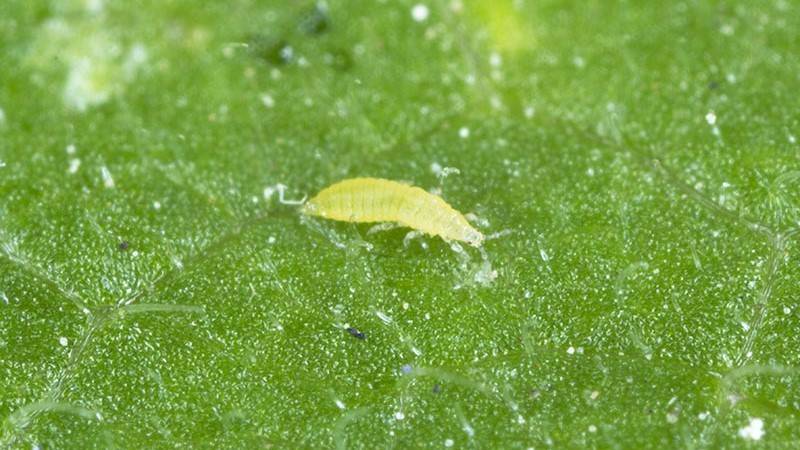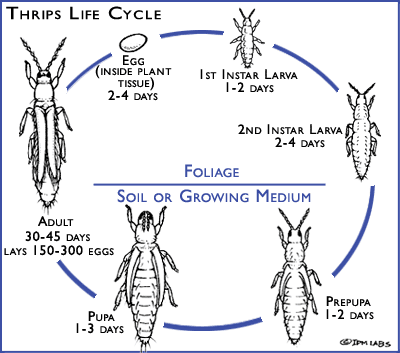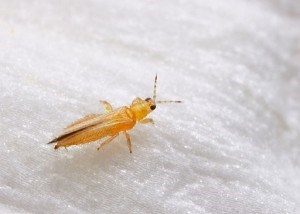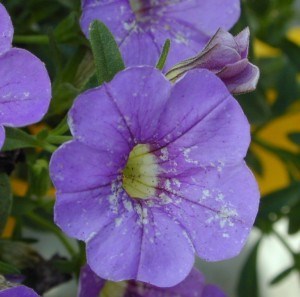Critters Down Under: Thrips


Thrips are a common insect pest that most growers have had difficulty controlling due to their small size and ability to hide in plant parts. Although this is not an insect associated with growing media, most species of thrips spend part of their lifecycle in the growing medium or soil. Thus, the question arises whether they can come from unused, packaged growing media. The simple answer is that it is very unlikely. To understand why, we will address the life cycle of thrips and the common issues associated with them.
Lifecycle
There are about 5,000 different thrips species in the world and those that have wings are the smallest winged insects. Most feed on fungi while living in leaf litter or decomposing wood, but some of these species feed on live plants. Although there are some variations among each species, there are 6 stages in their life cycle, as seen in Figure 1. The length of the lifecycle is greatly influenced by temperature: the warmer the temperature, the faster the life cycle. Common thrips species that attack greenhouse crops are tiny, typically 1-2 mm in length, and are active in a temperature range of 50-90°F (10-32°C), but their optimal range is 80-85°F (27-30°C). Thrips do not develop at temperatures below 50°F (10°C).

Female adults lay eggs in live plant tissue through their ovipositor. The eggs hatch within 2-4 days, thus beginning the first of two larval stages (see Table 1). The first instar stage lasts 1-2 days, then after molting begins the second instar stage, which lasts 2-4 days. In these two stages, thrips are voracious eaters by using a mandible to punch a hole into a plant cell and insert a stylet which draws out the contents of the cell. Depending on the species, they feed on the base of flower petals, pollen, young fruit and/or new tender leaves in the terminal ends of stems. They are very hard to see as they are well hidden and smaller than adults.
| Stage | Approximate Duration at 68-98 °F (20-37 °C) | Location* | Plant Damage |
|---|---|---|---|
| Egg | 2-4 days | Young leaves, flowers | No |
| First Instar | 1-2 days | Young leaves, flowers, fruits | Yes |
| Second Instar | 2-4 days | Young leaves, flowers, fruits | Yes |
| Prepupal Stage | 1-2 days | Soil/growing media | No |
| Pupal Stage | 1-2 days | Soil/growing media | No |
| Adult | 30-45 days | Young leaves, flowers, fruits | Yes |
At the end of the second instar stage, thrips relocate to the growing medium. While there, thrips go through a prepupal stage where they start to develop wing pads. This stage lasts 1-2 days. The next stage is the pupal stage in which the wings develop, consisting of long sparse hairs giving a feather-like appearance. The pupal stage lasts 1-3 days until the wings are fully developed, and then they emerge from the growing medium as adults. During the prepupal and pupal stages in the growing medium, thrips are inactive and do not feed or cause plant damage.
Emerging adults fly from the growing medium to feed on flowers, young leaves, pollen and/or developing young fruit. Adults live for 30-45 days, causing damage to the plant parts they feed from, and females deposit eggs within plant tissues. The lifecycle of a thrips is 21 days or less if the temperatures are hot. Females can lay up to 150-300 eggs, depending on the species. Once the weather gets cold, some thrips can hibernate as eggs in leaf litter or soil outside or under benches in the greenhouse. Some thrips can also migrate from southern tropical regions into the United States and Canada during the spring months.
Common Thrips in Greenhouse Crops
The most common and destructive thrips species that infest greenhouse crops is Western Flower thrips (Frankliniella tritici). The adults are light yellow to brown and when their wings are folded on their back, there is a dark stripe down the middle. Other common thrips species include:
- Flower thrips (Frankliniella occidentalis)
- Chilli thrips (Scirtothrips dorsalis): Are pale green to yellow with dark wings and smaller than the other thrips.
- Banded greenhouse thrips (Hercinothrips femoralis): Pupae in plant tissue, not the soil or growing medium.
- Echinothrips (Echinothrips americanus): Also pupae in plant tissue, and are dark brown with a white band on the back at the base of the wings. They typically feed only on foliage.
- Onion thrips (Thrips tabaci): Have a uniform yellowish-brown color.

Damage Caused
Because thrips typically feed on the contents of individual cells, these empty cells collapse, causing silver speckling or streaking on tissue surfaces (Figure 3). If feeding continues, it can lead to deformed flowers, leaves and shoots. On fruit, it can cause a small dimple followed by a white halo surrounding the dimple. In some fruits, feeding can eventually lead to scarring and “corky” tissue.
Perhaps of greater concern is the transmission of viruses while feeding. For example, Western flower thrips transmit two highly destructive tospoviruses: impatiens necrotic spot virus and tomato spotted wilt virus. These two viruses are known to affect over 600 plant species, especially begonia, cineraria, cyclamen, exacum, gloxinia, impatiens, New Guinea impatiens, primula and ranunculus. Onion thrips and chilli thrips are also known to vector viruses.

Sources of Thrips
Thrips are hard to control and can be found on crops, pet plants or weeds in a greenhouse. Thrips can be brought into a greenhouse on plugs, cuttings, liners, prefinished crops and work clothes, or come in from the outdoors from late spring through fall. Weeds or field crops near a greenhouse can have high populations of thrips, especially those in flower. This is especially a concern if crops are being harvested or flowering weeds are cut down as thrips search for new plant hosts.
Although many thrips species that infest greenhouse crops spend part of their lifecycle in the soil or growing media, this does not mean that the growing medium is the source of thrips. It is very unlikely for thrips to occur in unused, packaged growing media. However, if thrips were somehow introduced to unused growing media in the prepupal and pupal stages (which last 2-4 days), the emerging adults would not have a food source and would die. If there were eggs, warm storage temperatures would stimulate hatching and the nymphs again would not have a food source inside the packaging and would die.
For more information about thrips, please consult your extension service or University websites.